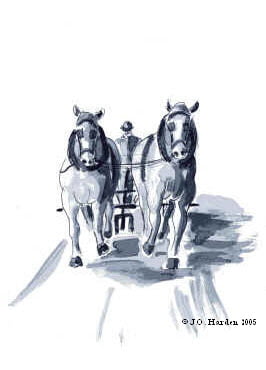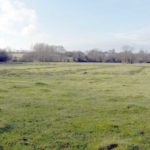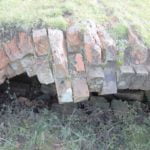
Fovant Water Meadows
Many riverside meadows have flooded naturally, but the first recorded use of deliberate flooding of fields was not until the early 17th century. In 1610 Roland Vaughn published ‘The Most Approved and Long Experienced Water Workes’ which described his work in Herefordshire. He had connections with Herbert, Earl of Pembroke, who embraced the new ideas enthusiastically. There are early mentions of ‘wet meads’ and ‘water closes’ at Barford St Martin, Dinton, Chilmark and Teffont. This last could very well be the Fovant meadows which are sited on the Nadder River opposite Teffont Mill, and there are a few signs of meadows on the Teffont side of the river.
By the 1650s watering of meadows was well established at Sutton Mandeville.
To see a larger version of any of the photographs that appear on this page, just click on them. They were taken in 2006 and 2007.
Water meadow systems opposite Sutton Mill, still visible today
The added value of floated land was recorded in the Church Warden’s accounts of rates to be paid to the Parish. Dry or unwatered land was charged at 12s. 0d. per acre whereas watered meadows were 24s. 0d. The improved farming advantages soon became apparent. The gently moving water prevented the ground from freezing during the winter allowing grass to grow much earlier than on undrowned fields. Sheep could be grazed on the first flush during the day.
Water meadow systems opposite Sutton Mill, still visible today
The added value of floated land was recorded in the Church Warden’s accounts of rates to be paid to the Parish. Dry or unwatered land was charged at 12s. 0d. per acre whereas watered meadows were 24s. 0d. The improved farming advantages soon became apparent. The gently moving water prevented the ground from freezing during the winter allowing grass to grow much earlier than on undrowned fields. Sheep could be grazed on the first flush during the day.
Roughly worked stones and metal at Manor Farm, Fovant
They were then driven to the nearby higher fields where they were enclosed by hurdles for the night. The breed used by Wiltshire farmers conveniently produced their ‘fertiliser’ only at night, therefore keeping the water meadows clean but providing well-manured fields for growing crops when spring arrived.
The Fovant Water Meadows drew water from the River Nadder but also extensively from Fovant Stream as it flowed from the springs at West Farm to join the Nadder near Teffont Mill. The flooded fields stretched from what later became part of the watercress beds and which is now an ornamental lake. .
Also marked on the map are the sites of old cottages. These are shown on one of the documents in Salisbury & S. Wilts Museum collected by the late Dr RCC Clay.
Later, after the first flush of growth had been utilised by the sheep, they were driven to the Downs where they thrived on the rougher grasses and wild flowers which abounded there. The grass on the meadows was allowed to grow and provide hay for winter feeding of stock. Because of the continual movement of stock and harvesters, the maintenance of the carriers and drains was a never-ending task. The flow of water needed to be constantly monitored, making it necessary for the Drowner and his staff to live on the spot. Foundations and garden boundaries of these houses can still be seen in Little Coppice and Barn Ground.
Many signs of hatches remain along the banks, and the carriers and ditches can be clearly seen even after 70 years of neglect. The main carrier brought the water to a central point from which several hatches could control the drowning of various areas.
Carriers and drains are still visible although no maintenance has taken place since the 1930s.
The drains were protected from too much damage caused by the movement of stock and farm workers harvesting the hay crop in late summer.
The authors would like to thank the Brimclose Fishing Club for their help in exploring these meadows.
More about water meadows in general can be found at the Farm Direct website.
M.A.M.
B.P.
Dec 2007









